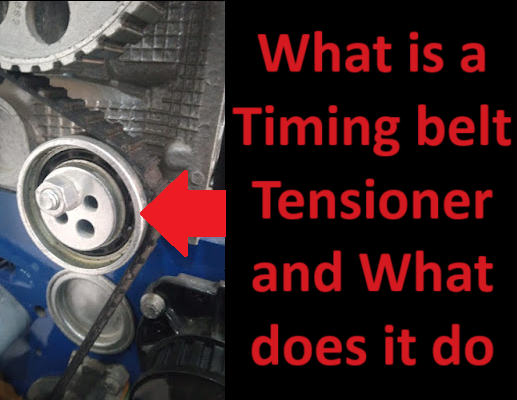Timing belt tensioner play an important role in the proper function of an engine. It is a key player in maintaining the synchronization of the engine valve and piston movement.
This article gives you a comprehensive overview of what it is. What does it do? And what are the causes and symptoms of a bad tensioner?
If you want to know the difference between serpentine belt and a timing belt. Do read our other article as well.

What is a timing belt tensioner?
A timing belt tensioner also known as a timing belt tensioner pulley is an idler pulley for the engine timing belt. It is designe to adjust the tension of the timing belt as and when needed.
There are two main types of tensioner, a spring-loaded tensioner and a hydraulic tensioner. Spring-loaded tensioners are more common as they are very easy to adjust and maintain.
What does the timing belt tensioner do
A timing belt tensioner is use to adjust the tension of the timing belt. It does so by pressing or releasing force on the timing belt.
Without the correct tension, the timing belt can slip from eight crankshaft or camshaft. Unsynchronized piston movement with value opening will cause total engine failure
A timing belt tensioner tool is use to adjust the tension of the belt. This tool simply helps to move the tensioner and apply or release the force of the belt.
To adjust the tension of the timing belt. Lose the tensioner center nut and use the tensioner tool to adjust the tension of the belt. Once the belt is tight, tighten the tensioner center nut.
A mechanical timing belt tensioner tool is just a simple bar with two pins at its one end. These two pins get fixed in two holes on the tensioners and the bar can move the tensioner to adjust the tension.
Cause of timing belt tensioner failure
There are five main causes of timing belt tensioner failure. Following is a comprehensive explanation of what can cause the tensioner to fail.
1. Tensioner has served its useful life
One of the most common causes of timing belt tensioner failure is the tensioner age. Like all parts, it also has a fixed useful life and usually needs to be replaced after that. So if your tensioner has served its useful age then it needs replacement.
2. Tensioner is subjected to wear and tear
If the engine timing belt tensioner has been subjected to wear and tear due to extensive use. Then there are chances that the tensioner is failing or has already failed.
3. Tensioner was not installed correctly
If the tensioner is not installed correctly, then it can experience more than the required pressure on it. This extra pressure can cause it to fail. Selecting the wrong tensioner for the job or any type of misalignment can cause tensioner failure.
4. The timing belt tensioner has Dirt and dust build-up in its body
The timing belt is usually covered but if not then dust and debris can cause the tensioner to fail prematurely. Tensioner rotates continuously with the timing belt. Any dust can cause a lot of wear and tear.
5. The low-quality tensioner is installed
A low-quality timing belt tensioner can cause hydraulic oil leaks or tensioner spring issues. The only possible solution to this and that is to replace it with a new quality tensioner.
Symptoms of bad timing belt tensioner
If your timing belt tensioner has gone bad or is going bad then it will show symptoms. There are 4 symptoms of bad timing belt tensioner.
1. Strange noise coming from the timing belt tensioner or its cover plate
One of the most common symptoms of a bad tensioner is the unusual noise coming from under the timing belt cover plate. Rattling, Squeaking or squealing and Knocking noises are usually signs of a bad tensioner.
2. Excessive vibration of tensioner or timing belt
Excessive vibrations are observed coming from the tensioner or timing belt, then it is a symptom of a bad timing belt tensioner. Vibration can be due to misalignment, loose belts, and dust in the tensioner pulley.
3. Engine misfiring, poor acceleration, and low overall performance of the engine
The timing belt is responsible for proper engine operation and performance. A faulty tensioner will make the timing belt so loose. A loose belt means a lack of required synchronization and thus low engine performance, misfiring, and poor acceleration.
4. Engine check engine Light will come on
As timing belts deal with the engine and if anything is wrong with the engine then check engine light is on. If there is no other trouble code check engine light and any of the above signs are noticed. Then it’s a faulty timing belt or timing belt tensioner.
Do I need to replace tensioner with timing belt
Yes, it is highly recommended to replace the tensioner with the timing belt. As both have the same life and work like a mechanism. So it’s better to change both at the same time rather than changing them separately.
How long can you drive with a bad timing belt tensioner
You cannot drive much with a bad timing belt tensioner. A tensioner makes the timing belt work perfectly and a bad tensioner means a bad timing belt.
A bad timing belt means a lack of required synchronization. No synchronization means your engine will not work properly or may not work at all.
So it’s highly recommended to change the tensioner immediately.
Last Words
The timing belt tensioner is what makes the engine timing belt work properly. It is used to adjust the tension of the timing belt.
If you have any questions about it, comment and we will respond accordingly.
